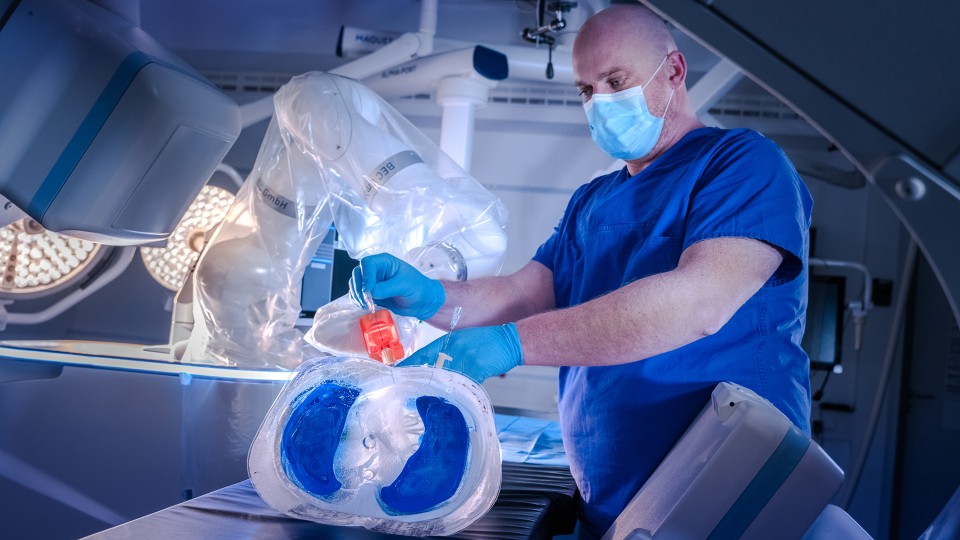
guidoo

guidoo – A robotic assistance system for fast and precise biopsies
Imagine you have to hit a pea-sized target with a knitting needle and that target is more than a hand's breadth deep in an opaque body. You know the puncture site, the angle and the depth of the puncture, but it is done manually. So you need some skill to hit the first time - doctors face a similar challenge every day when they perform biopsies.

Privacy warning
With the click on the play button an external video from www.youtube.com is loaded and started. Your data is possible transferred and stored to third party. Do not start the video if you disagree. Find more about the youtube privacy statement under the following link: https://policies.google.com/privacyPuncturing organs as a major challenge in everyday clinical practice
The puncturing of organs such as the liver or kidney for a biopsy is part of everyday clinical practice. In such a biopsy, a doctor punches a needle to take a tissue sample from the body of a person to be treated. This sample is then analysed and can provide information about the tissue. In the search for the correct diagnosis, this can give the decisive indication. Thanks to modern technology such as computer tomography or magnetic resonance imaging, we are now able to visually detect changes in tissue that are just 1 cm in size - but it is still unknown whether they are benign or malignant. However, since these "lesions" often lie in the depth of the body, it takes some practice to hit such a small target and take a sample. Imaging procedures such as X-rays are therefore used to check whether the right spot has been hit and, if necessary, to correct the position of the needle again and again. Sometimes this is necessary, but damages the patient through injuries in the tissue and the additional radiation exposure. In addition, the duration of the procedure is prolonged, which increases the risk of complications in narcotised patients, uses treatment rooms longer than necessary and thus causes higher costs.

Robotic assistance increases speed and reliability
This is where guidoo comes in: The robot arm, based on a previous planning, guides a needle roller cup to the insertion point and thus offers a guide for the biopsy needle. Doctors insert the biopsy needle through this sleeve. This allows them to concentrate on the precise penetration depth while the positioning and angulation of the needle is supported by the robot. The hit rate is increased and repeated punctures and excessive control scans are avoided. This not only protects patients, but also increases the speed and reliability of the procedure: This leads to "economy by speed".

Guidoo is the result of successful cooperation between research institutes, industry, and clinics.
guidoo is the result of a series of projects, the EU project "MITIGATE", the research campus "M²OLIE" and last but not least a project of the Central Innovation Programme for Small and Medium-Sized Enterprises (ZIM). Within the final project the BEC GmbH, the University Medicine Mannheim, the Fraunhofer IGD, as well as the Fraunhofer IPA cooperate with its department »Clinical Health Technologies«. First, the software and hardware were developed in a co-creation effort, and then the usability as well as time and precision advantages of the system were tested in preclinical and clinical studies on phantoms and during actual surgery on humans. This study is currently ongoing and should ultimately confirm the market readiness of guidoo. In parallel, further developments and key experiments with guidoo are being prepared to expand its application portfolio and qualify it for further needle-based interventions.
 Fraunhofer Institute for Manufacturing Engineering and Automation
Fraunhofer Institute for Manufacturing Engineering and Automation